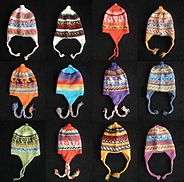Huacaya (alpaca)

Huacaya or Huacaya alpaca is the one of the two breeds that make up the species Vicugna pacos , commonly known as the alpaca. The other breed is the Suri.[1] It lives on the Altiplano plateau in the Andes at up to 4,000 m above sea level. Its natural range encompasses four South American countries.
Phenotype characteristics
Both breeds are easily identifiable by their phenotypic characteristics.[1] There are no differences in weight, or pup at birth (7.5 to 8 kg) or the adult specimens, weighing about 70 kg in males and 65 kg in females.[2]
Animals of the Huacaya breed have a rounded and bulky appearance. Huacaya fiber grows perpendicular to the body of the alpaca, and is bulky, smooth and dense. Its curls in its sponge-like fibre are shorter and duller compared with Suri, with an absence of wool grease that is characteristic of Corriedale sheep.[1] Suri fiber instead lies parallel to the body in long hanging well-defined locks which grow towards the ground. The fibre is silkier and more lustrous than that of the huacaya, as well as being longer.
Both breeds possess a vast array of coat colors, totalling 22 different varieties.
Population
Huacayas far outnumber the Suri population. In Chile, all alpacas are of the Huacaya type, and there is a negligible amount of Suri specimens in Bolivia at the northern border. Peru, which contains the majority of the world's alpaca, has 93% Huacaya as estimated by the Food and Agriculture Organization.[3] Thus of the 3.7 million animals worldwide, more than 90% are thought to be of the Huayaca breed.[4]
Products

Fibre
Their wool is made up of between 150-170 threads / mm².[5][6] At 25 μm thick, their wool is 1.5 μm thinner that of the Suri, and considerably whiter, on average. Suri wool is marginally stronger[4] Some of the products that can be made with fine Huacaya fiber include:
Meat
While Vicugna pacos were never bred for meat, it is a useful by-product and that their meat is perfectly edible and very high in protein. The carcass weight varies at a round 50% of live weight and 23 kilogrammes.[7] Huacaya are thought to produce more meat than the Suri.[8] Alpaca meat has a high protein to fat ratio, with the most common breed containing on average 23% protein.[7]
References
- 1 2 3 Manna, V. La; Terza, A. La; Dharaneedharan, S.; Ghezzi, S.; Saravanaperumal, S. Arumugam; Apaza, N.; Huanca, T.; Bozzi, R.; Renieri, C. (2011-01-01). Pérez-Cabal, Ma Ángeles; Gutiérrez, Juan Pablo; Cervantes, Isabel; Alcalde, Ma Jesús, eds. A microsatellite study on the genetic distance between Suri and Huacaya phenotypes in Peruvian alpaca (Vicugna pacos). Wageningen Academic Publishers. p. 1. doi:10.3920/978-90-8686-727-1_20. ISBN 978-90-8686-727-1.
- ↑ Fernández-Baca, Sr. Saúl (2005). SITUACIÓN ACTUAL DE LOS CAMÉLIDOS SUDAMERICANOS EN PERÚ (PDF) (in Spanish). Food and Agriculture Organisation of the United Nations. p. 13. Regional TCP project TCP/RLA/2914.
- ↑ Quispe, E.c.; Rodríguez, T.c.; Iñiguez, L.r.; Mueller, J.p. (2009-10-01). "Producción de fibra de alpaca, llama, vicuña y guanaco en Sudamérica". Animal Genetic Resources Information. 45: 1–14. doi:10.1017/S1014233909990277. ISSN 2078-6344.
- 1 2 Atav, Rıza; Türkmen, Fatih (2015-08-01). "Investigation of the dyeing characteristics of alpaca fibers (Huacaya and Suri) in comparison with wool" (PDF). Textile Research Journal. 85 (13): 1331–1339. doi:10.1177/0040517514563727. ISSN 0040-5175.
- ↑ Maccagno, Luis. (1912) La raza de alpaca Suri. Anales de la Dirección de Fomento de Lima (Perú), Números 7-12.
- ↑ Romero, Elías C. (1927) Llamas, alpacas, vicuñas y guanacos. Imp. F. Gurfinkel. 203 páginas.
- 1 2 Salvá, Bettit K.; Zumalacárregui, José M.; Figueira, Ana C.; Osorio, María T.; Mateo, Javier (2009-08-01). "Nutrient composition and technological quality of meat from alpacas reared in Peru". Meat Science. 82 (4): 450–455. doi:10.1016/j.meatsci.2009.02.015.
- ↑ Huarachi, David. Manual cría de camélidos sudamericanos. Ediciones Kollu Huma. 54 páginas.